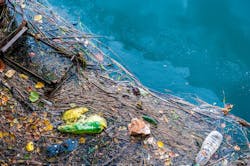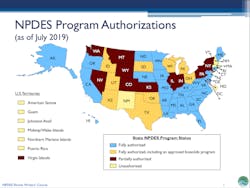What is the National Pollutant Discharge Elimination System (NPDES)?
The National Pollutant Discharge Elimination System program, known as the NPDES for short, was designed to reduce water pollution in the United States. This guide will explore the history, purpose, and benefits of this program.
The NPDES: A Definition
The NPDES is a permit program that was established in 1972 by the Clean Water Act (CWA). This program regulates point sources of pollution discharge in the U.S. to address pollution across the country.
The NPDES program controls pollution in two ways: with water quality-based limits and technology-based limits.
The U.S. Environmental Protection Agency (EPA) administers, enforces, and oversees the NPDES permit program for all governments. 47 states and one territory are currently required to implement the NPDES program. Some states have the authority to administer the NPDES program within their state. States may submit a handful of criteria to be reviewed by the EPA for NPDES authorization. Below is a map from the U.S. EPA website indicating authorizations on a state-by-state basis as of July 2019.
What Are NPDES Permits?
NPDES permits are a type of permit that enable facilities to discharge pollutants into a water source under certain conditions. An NPDES permit may also act as a license for a facility to landfill, incinerate, process, or use sewage sludge. The EPA has additional resources on the permit program on its website. Some states have the authority to including a map of authorization on a state by state basis.
Types of NPDES Permits
The two types of NPDES permits that a facility may be issued are general and individual permits.
General Permits
General permits are those that cover a group of facilities that have similar qualities and are based within a specific region. A single general permit can cover a big group of facilities, which makes this type of permit appealing from a cost perspective.
Individual Permits
Individual permits are those that are produced and issued to a single facility, based on an application the permitting authority receives from the facility. An individual permit can be tailored to the facility based on the information provided by the facility — such as the nature of discharge, the type of activity, and the receiving water quality — in the permit application. Individual permits have a maximum issue period of five years, and the facility must apply for the permit again within this issue period.
Why Does the National Pollutant Discharge Elimination System Exist?
Water pollution is dangerous and degrading to water sources, making them unsafe for fishing, swimming, drinking, and other activities. Pollution also affects the environment and poses a risk to the habitats in these water sources.
The EPA’s NPDES program aims to regulate pollution in the US, with the goal of preserving and protecting the nation’s water sources. By monitoring and overseeing facilities that contribute to pollution, the EPA has better control over what types and quantities of pollutants end up in the environment.
NPDES Public Participation
Members of the public are entitled to review draft permits from facilities in their local area to learn about how these permits may affect them. Getting involved early in the permitting process gives one a good opportunity to prepare a statement or make notes on the draft permits, which can be submitted to a local authority in writing or spoken at a public hearing.
The public can request copies of application forms for individual permits in its local area from its permitting authority. These application forms should tell people everything to know about the proposed discharge, including the processes taking place in the discharge facility, the location of discharge, and the type and amount of pollutants that will be discharged.
General permits are issued to a group of facilities by a permitting authority, so there are no application forms for the public to review. Instead, the public is invited to comment on the proposed general permit, either online, via email, or via a mailed written statement. The permitting authority reviews and evaluates all comments, and decides whether or not the permit should be issued.
The applications for EPA-Issued NPDES permits can be viewed here.
Appealing an NPDES Permit
Even after a permit has been reviewed, approved, and issued by a permitting authority, members of the public can still appeal this permit if they are unhappy with its terms. Typically, one will only be able to appeal a permit if they had participated in a hearing for the permit or submitted comments on a draft of the permit.
Appeals should be made to the Environmental Appeals Board, which will review the permit and potentially challenge the permitting authority’s actions.
How are NPDES Permits Enforced?
Facilities that hold an NPDES permit are typically required to monitor and submit information about the volume and type of pollutants they discharge, and the discharge location. This information is usually shared in a Discharge Monitoring Report, and is made available for the public to view by the permitting authority.
Any facility that violates its permit or is discharging without a permit can be reported to the National Response Center here.
Takeaway
The National Pollutant Discharge Elimination System program was established by the Clean Water Act and is enforced by the Environmental Protection Agency to monitor and regulate water pollution in the US. NPDES permits may be issued to a group of facilities by a permitting authority, or individual facilities may apply for an NPDES permit by submitting an application form. There are plenty of opportunities for members of the public to comment on, or appeal, an NPDES permit.
About the author: Brian Campbell is the founder of WaterFilterGuru.com, where he blogs about all things water quality. His passion for helping people get access to clean, safe water flows through the expert industry coverage he provides. Follow him on twitter @WF_Guru or contact him by email [email protected]
About the Author
Brian Campbell
Brian Campbell is the founder of WaterFilterGuru.com, where he blogs about all things water quality. His passion for helping people get access to clean, safe water flows through the expert industry coverage he provides. Follow him on twitter @WF_Guru or contact him by email [email protected].

